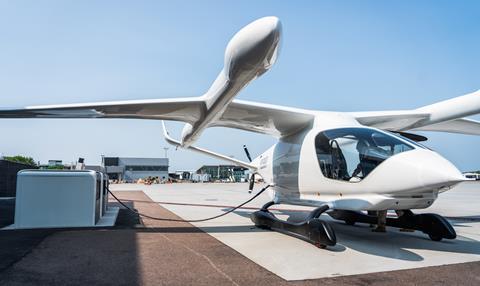Electric airframer Beta says it has completed a three-month test deployment with the US Air Force (USAF), which sought to evaluate the suitability of the company’s all-electric Alia aircraft for military service.
Beta’s experimental aircraft, which was the first crewed electric type to receive airworthiness certification through the US military, was assessed on a number of criteria, including flight operations, maintenance support and infrared signature characterisation.
The Vermont-based start-up delivered a conventional take-off and landing Alia variant to the USAF last October, after a more than 1,500nm (2,770km) deployemnt from Beta’s headquarters in Burlington, Vermont to Eglin AFB in Florida.

During that multi-leg journey, Alia became the first electric aircraft to fly through the heavily restricted airspace around Washington DC and the first all-electric type to land at Andrews AFB near the US capital.
Beta also installed the USAF’s first electric aircraft charging station as part of the programme.
The three-month evaluation of Alia was part of the service’s Agility Prime programme, exploring potential military applications for electric aircraft. Agility Prime is being administered by the USAF’s AFWERX technology incubator.
Personnel from Beta and the USAF’s 413th Flight Test Squadron assessed the Alia platform for a range of missions, including critical resupply, cargo delivery and personnel transport.
Alia also participated in a casualty evacuation exercise, in which the experimental aircraft operated alongside a Sikorsky HH-60W combat rescue helicopter.

That scenario saw the HH-60W retrieve a simulated casualty from enemy territory, before transferring the patient to an Alia flight crew in friendly space.
“The Alia aircraft performed the patient transport to definitive medical care from the operating location, relieving the HH-60W Jolly Green II crew, completing the first [casualty evacuation] and first direct operations mission with the USAF for an electric aircraft,” Beta says.
The company notes the teaming saw improved response times and lower operating costs, when compared to a similar scenario that paired an HH-60W with a Lockheed Martin C-130 fixed-wing transport.
“A similar C-130 patient transport requires similar runway length and would require a crew of at least three and approximately $1,600 in fuel,” Beta says. “The Alia aircraft accomplished this simulated mission with a crew of two and an energy cost of approximately $5 in electricity.”
Another mission saw the Alia deliver parts for a Lockheed F-35 fighter, in support of maintenance operations.
Beta notes the various Alia sorties generated average energy costs of $15 per flight during the during the three-month test programme.
The airframer is also developing a vertical take-off and landing (VTOL) variant of Alia, which would eliminate the need for a maintained runway.
Beta is pursuing civil type certification for the Alia with the US Federal Aviation Administration. It predicts a 2025 entry in to service for the conventional Alia variant, with the VTOL Alia type following in 2026.
While the USAF has not yet made a decision regarding the procurement of electric aircraft, Agility Prime programme manager Andrew Lau on 29 January indicated the service likely will purchase the Alia.
The USAF is “definitely on an acquisition path to get these into the inventory”, Lau said in an interview with DefenseOne.
Other US electric aircraft developers, including Joby Aviation and Archer Aviation, are also participating in Agility Prime.


























